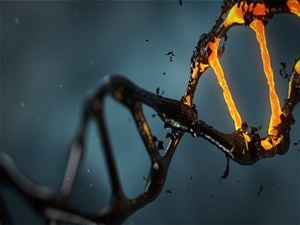
Genetic experiments sound like something out of a science fiction novel or comic book. Genetic experiments, however, are very real and have been for quite some time. The earliest genetic experiments were actually nothing like what most people today picture when they think of genetic engineering. In fact, the earliest human attempts at altering another organism’s genetic code are now called selective breeding. In these ancient events, humans made it a point to replant the seeds of organisms that grew larger, sweeter or better fruit. As such, vegetables and fruits that humans had domesticated became larger or more nutritious. This change can be seen dramatically when a picture of modern day corn on the cob is placed next to an image of ancient maize. The two plants are almost unrecognizable. Ancient maize had little more than a handful of small kernels. Modern corn, of course, is nearly a meal in an of itself.
When it came to animals, ancient civilizations did much the same thing. Males that had the thickest wool or best temperament were allowed to breed with females. Males who were scrawny or foul tempered usually found themselves on the chopping block and did not have the time or ability to breed at all. Just as with plants, the animals that humans had modified ended up looking very different from their non-domesticated cousins. Perhaps the most striking example of this transformation would be the difference between a Yorkshire Terrier that can fit into a woman’s purse and the timber wolves from which man’s best friend descended. The two creatures look like they do not belong on the same planet, much less a related gene pool.
Genetically altering human beings has been far more out of humanity’s reach than experiments on their own kind. This was largely because the sort of selective breeding that was used for animals and plants would not work as well on humans. That is not to say that there are not some morbid and unpleasant procedures and tests lurking in history, but people in the past were highly reluctant to risk their children. The rise of genetics as a true science brought the possibility of human genetic experimentation into sharp relief, but it was not until the completion of the Human Genome Project in April 2003 that human genetic modification became a real and urgent issue.
The debate over genetic experimentation and genetic modification has raged for decades. Two common concerns raised were those that dealt with privacy and safety. Should genome sequencing become commonplace, how would that information be protected? Would genome discrimination arise as people who had genetic predispositions to diseases or dangerous behaviors be treated differently than those who had a healthier genome? Could genetic testing prevent a person from covered by insurance or taking on certain high risk jobs if they had unfavorable genes?
The risks for privacy were certainly real, but safety in genetic research was a more urgent concern and failure could result in catastrophic consequences. Genetic experiments are usually very safe, and many experiments have limited consequences should they fail. The world, after all, is unlikely to end because an attempt to make wheat immune to leaf rust does not work. That said, there are some genetic experiments that use viruses as part of their procedures. Viruses have the ability to cut apart DNA strands and reconfigure them faster and easier than any sort of human technology. As such, viruses have been used to cut apart DNA strands so that the smaller pieces could be studied. Normally, there are no issues with such procedures, but occasionally the virus has rebelled. Instead of cutting apart the DNA for researchers to study, viruses have reconfigured the DNA and added it to their own. Frantic scientists have had to pull the plug on experiments to keep the viruses from potentially mutating into the sort of super-plague that belongs in post-apocalyptic novels and zombie movies.
Even though the idea of viruses playing around with DNA is terrifying, the largest concern for most religious groups is that of ethics. Where is the line between curing genetic disorders and playing God? How will anyone know when that line is crossed? What will people do when it is? Religious groups, and even some scientists, have also been very clear on the fact that when it comes to genetic modification, the question is “when” not “if.” The perfect example of this is Clustered Regularly Interspaced Short Palindromic Repeats or CRISPR. CRISPER is a system meant to target specific sections of DNA in order to allow scientists to delete parts of the genetic code or to insert new genetic material. Theoretically, the technology could eventually be used to eliminate parts of the human genome that lead to a crippling disorder or death, such as Huntington’s Disease. The use of technology on humans, however, was supposed to remain theoretical, not in the least because there are long sections of DNA whose functions are still unclear. It may be useless filler space, as some scientists theorize, but it might also be responsible for keeping humans from contracting certain diseases. Some scientists posit that the so-called empty sections of DNA are actually portions of viral or bacterial DNA that earlier humans contracted. With the pathogen’s DNA embedded in their own genetic code, humans became immune to the diseases. Removing these sections could be catastrophic.
Arguments over CRISPR were supposed to remain purely theoretical, but He Jiankui, a Chinese scientist, defied the international moratorium on editing human embryos intended for pregnancy. Quietly, and without oversite, He edited the genome of two twin girls who have since been born. Scientists across the world have been up in arms. Even those who are comfortable with the shaky ethics involved with the experiment were concerned at He’s actions. The CRISPR technology, they said, was not safe or precise enough to be used on human embryos. Nevertheless, He has announced there is a third potential CRISPR baby on the way.
It is very hard to stuff the genie back in the bottle once he has escaped, and that is exactly what worries most Christians. Genetic modification has the potential to do great things from curing genetic diseases such as Huntington’s to eliminating cancer and HIV. It can, however, be used to create designer babies and even lead to the rise of a belief in a new superior race, one that has been edited to be perfect. Christians will undoubtedly have a wide range of opinions on genetic experimentation, but one thing should be at the forefront of all of their minds. When does genetic modification become playing God, and what do people do when that line is inevitably crossed? Can people close Pandora’s box?

